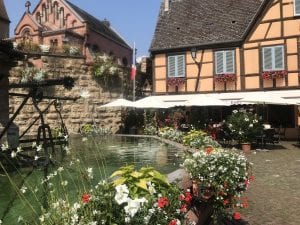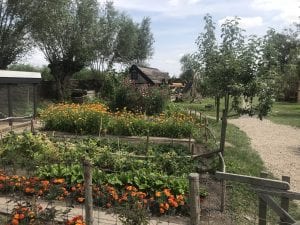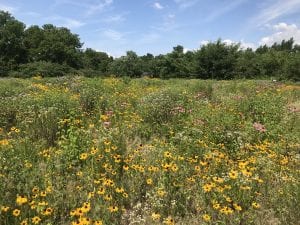2018 has been a tough year so far for plants. A tally of monthly data from DEOS (the Delaware Environmental Observation System) indicates most areas in the state are already over the average yearly rainfall (41 inches of rain per year in Delaware) and we are only three quarters of the way through the year! We were 5-10 inches ahead in May depending on the location in the state. Planting and plant growth were delayed this spring due to cold and wet soils. Temperatures increased in June and July, but rainfall amounts were still above average. We had about 47 rainy days out of 100 this summer. That is unpleasant for us humans, but it is also really bad for plants. We also had a two-week dry period in early July with high temperatures that resulted in stressful dry conditions.
All this rain led to saturated soils. Soils are comprised of minerals (sand, silt or clay), organic matter (decaying plants and animals), and some combination of air and water. Soils with good structure have equal parts air and water leading to healthy plants. Clay soils tend to have small pore spaces resulting in more water than air. When clay soils receive excess rain, the percentage of air decreases and water increases even further. Plants need both oxygen and water for growth. When roots sit in water logged soil the result will be poor root development and plant health problems, especially with newly transplanted trees and shrubs. Low lying and wet areas are conducive to root rot microbes. Regular rain also results in a constant coating of moisture on the leaves, which encourages the spread of diseases. So, we have had a summer of many plant diseases from root rots to leaf spots and everything in between.
Let’s talk vegetable gardens. Most got off to a slow start with poor seed germination due to waterlogged seedbeds. The constant film of water on leaves meant more leaf diseases than normal. Tomatoes really struggled and the tomatoes we did harvest were watery and less flavorful. The only plants that grew well in my vegetable garden this summer were the weeds!
Plants are most susceptible to excess water when they are actively growing. Root tips begin to die within a few days of waterlogging. Shallow root systems develop that have a limited ability to take up nutrients (particularly nitrogen) and water. It is ironic that excess water can cause plants to exhibit symptoms of drought stress. There is plenty of water, but a lack of healthy roots to take the water to plant leaves, so wilting occurs. Nitrogen is lost from waterlogged soils by leaching and denitrification (nitrogen lost as a gas to the air). These losses combined with less ability to absorb nutrients due to compromised roots systems may cause older leaves to yellow. Even plants that normally fix their own nitrogen (peas and other legumes) are impacted by waterlogged soils.
What does this mean for landscapes this fall and in the future? Be careful with trees in saturated soils. Trees with compromised root systems may fall over with strong wind gusts. Prune or remove dead or damaged trees near homes and buildings. My sister thought she heard gunshots and then fireworks as a tree fell on her property in August. I heard “fireworks” in the woods behind my home about a week ago only to find a fallen tree the next day.
Unfortunately, the effects of this bad weather summer may be with us for a while. Plants take time to grow new roots. If fall dries up a bit, we may get some root recovery since fall is a good time for root growth in most plants. But, evergreens do not grow roots in the fall, so they will really suffer next year. It is possible newly planted or stressed trees and shrubs may die as they try to leaf out next spring. Hopefully, we can chalk this growing season up as an anomaly and expect better growing conditions next year. Look at it as an opportunity to replace plants that die with native species that promote wildlife and a regional sense of place.
For more information about horticulture in Delaware follow me on Instagram at sbartonhort. For information about plant health follow Nancy Gregory at http://extension.udel.edu/ag/hot-topics-plant-disease/.


















